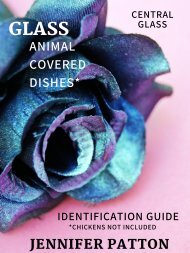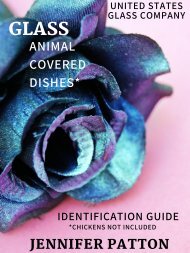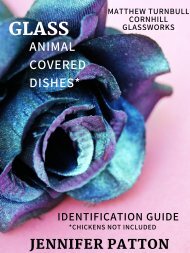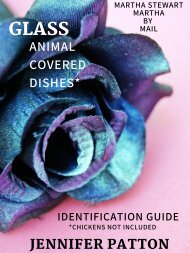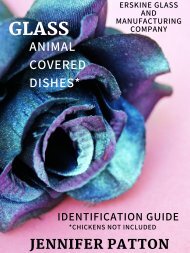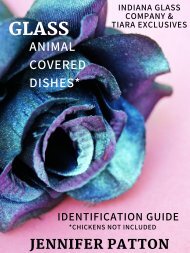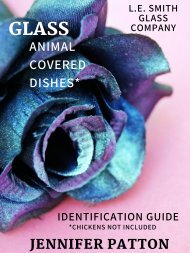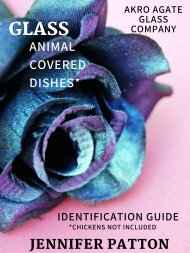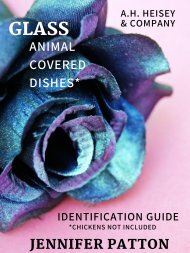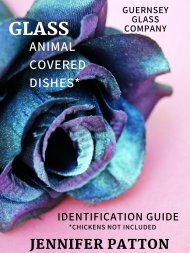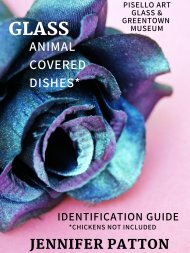Kemple & Westmoreland Molds
Create successful ePaper yourself
Turn your PDF publications into a flip-book with our unique Google optimized e-Paper software.
GLASS<br />
ANIMAL<br />
COVERED <br />
DISHES*<br />
KEMPLE &<br />
WESTMORELAND<br />
MOLDS<br />
IDENTIFICATION GUIDE<br />
*CHICKENS NOT INCLUDED<br />
<br />
JENNIFER PATTON
ABOUT ME<br />
Hi! My name is Jen and this is a little bit about myself. First, I must say this project was a lot of fun.<br />
Like a book from my gradeschool years lol. I don’t know if children today still do book reports, but when<br />
I was in school, they were required and boy did I dread reading the assigned books then having to<br />
summarize them! I loved reading books that interested me and hopefully this will interest you. I created<br />
it for anyone that needs help with identification. For the novice glass collectors that buy animal covered<br />
dishes because they fall in love with the way they look or the type of animals they are, or simply for<br />
their colors. For the avid collectors who enjoy buying a few of each animal regardless of the maker. For<br />
the veteran collectors who may have hundreds of glass dishes who never cease to amaze me with their<br />
beautiful collections. For the people that have inherited or purchased someone’s entire collection or<br />
part of a collection and need help to identify things. For the people like me that are meticulous about<br />
every detail needing to label things and just absolutely need to know the whats, whens, whos, hows and<br />
whys of the animal dishes they own. For me, what started with one Asian yellow stained glass bunny on<br />
a nest, has flourished into a full blown collection of hundreds of mixed and matched animal covered<br />
“candy” dishes of all glass types and colors. No particular glass maker, just everything I can’t live<br />
without. LOL. Anyone that knows me would tell you that I stop at nothing, studying book after book<br />
searching for answers about my own glass animals until I find them. I have never been satisfied with a<br />
mystery….unless it involves me watching Columbo, my lifelong favorite television program! I am a<br />
mystery solver... a true detective. I get this from my Mother, Cindy -Sultana- Wheatley. I need to get to<br />
the bottom of a piece of unidentified glass. It drives me bananas not to know everything I can about<br />
each piece that I own. Next, I will tell you that the monetary value of my glassware means nothing to<br />
me. I collect it because I love it. However, unique and rare is always a find! Sure, like every collector, I<br />
love a bargain and have had to pass up many pieces that I could not afford. Ooooh the ones that got<br />
away. They haunt me. I can assure you that when I get a new addition to my collection, it has found its<br />
forever home. Someone before me and usually possibly before them owned these animal covered<br />
dishes making a kind of history that I can only imagine in my mind, its importance to each person. There<br />
is a reason behind every single glassware in every single dwelling. Glass symbolizes many things. It is<br />
proudly displayed. It is important to the person who owns it. I enjoy seeing the happiness glassware<br />
brings to people, especially these animal covered dishes. Who doesn’t love animals? I also enjoy seeing<br />
my collection knowing these pieces of history live on and hope that when I am long gone, they will be in<br />
other homes. My glass brings me peace; most peaceful in the evenings when the cabinet lights are on<br />
and the glass does its natural thing; what it was intended to do since the day it was made...look pretty! <br />
To me, it is reminiscent of having a year round Christmas Tree. Glass is AMAZING! I am a country girl<br />
through and through. I love all things nature. I am an avid bird watcher and an all around animal lover. I<br />
live in the beautiful state of Kentucky with my husband and our two dogs, Monkey and Johnnie, who by<br />
the way, is named after my all time favorite singer, Johnny Cash.
Glass Animal Covered Dishes © Jennifer Patton<br />
glass animal covered dishes<br />
by Jennifer Patton:<br />
kemple & westmoreland molds<br />
copyright © 2022 by Jennifer Patton<br />
All rights reserved. No parts of this work may be reproduced without<br />
written permission from the copyright holder.<br />
No parts of this work may be reproduced for financial gain by anyone<br />
other than the copyright holder.
© Glass Animal Covered Dishes by Jennifer Patton<br />
Page 1<br />
look-a-likes: kemple and westmoreland acd<br />
My theory:<br />
I know speculation is not permitted in glass books, but I was very puzzled with the<br />
following extraordinary discovery. Please know there is no proof of what I am<br />
sharing. John and Geraldine <strong>Kemple</strong> claimed to have purchased many McKee Glass<br />
items, hundreds in fact, and some people have even considered their 5.5-inch animal<br />
covered dishes to be copies of original McKee animal covered dishes. This is simply<br />
not true. Yes, the Lamb and Dove on Nest are from original McKee molds, but any<br />
experienced ACD collector can recognize the remaining 99% of <strong>Kemple</strong> ACD in both<br />
5.5 and 7 inches are identical to <strong>Westmoreland</strong> Glass Company ACD! In Burkholder's<br />
<strong>Kemple</strong> Glass book, there is a list of molds and origins. Many glassware molds were<br />
purchased by a company named Mannington Glass Company. I looked into this<br />
company. I could not find much until I looked into the history of Mannington, West<br />
Virginia. This was a glass company that was in business between 1903-1909. Like so<br />
many other glassworks, it burned down. In 1919 it reopened as Homewood Glass<br />
Company. Not much reading literature was available online. What I find curious is<br />
that perhaps there was a typographical error when the researcher wrote down the<br />
origins of the <strong>Kemple</strong> animal covered dishes as McKee. It is my belief that<br />
Mannington Glass Company sold the animal covered dish molds to the <strong>Kemple</strong>s and<br />
they did not acquire Mckee Glass Company molds. Here is my theory...Hang on to<br />
your hats: Because so many <strong>Kemple</strong> 5.5" ACD lids and 7" lids and bases are identical<br />
to <strong>Westmoreland</strong> ACD and because many of the <strong>Westmoreland</strong> ACD suddenly<br />
appeared the same time as <strong>Kemple</strong> in the 1950's...What if they got their molds from<br />
the same place? And what if that place was Mannington Glass Company? I mean, it is<br />
IMPOSSIBLE for a <strong>Kemple</strong> ACD to look like a <strong>Westmoreland</strong> ACD that wouldn't have<br />
been defunct and up for sale until 1985. A minimum of 35 years into the future...15<br />
years after the close of <strong>Kemple</strong>! <strong>Westmoreland</strong>'s final auction was in 1985 and<br />
<strong>Kemple</strong> closed in 1970. Most <strong>Westmoreland</strong> molds were replicas of originals but the<br />
molds had been modified. So why is it so farfetched not to believe the <strong>Westmoreland</strong><br />
and <strong>Kemple</strong> animal covered dishes were purchased from the same glass factory????<br />
Question is...WHICH FACTORY? Just the fact that Mannington Glass items were<br />
purchased by John and Geraldine <strong>Kemple</strong> opens my mind into thinking Mannington<br />
Glass was selling molds and that leads me to wonder if they sold to <strong>Kemple</strong>, then<br />
who else did they sell to? As far as we know, Mannington Glass Company did not<br />
produce any ACD, but perhaps they owned the molds???? And perhaps<br />
<strong>Westmoreland</strong> also got the same ACD molds but changed the 5.5" bases.
© Glass Animal Covered Dishes by Jennifer Patton<br />
Page 2<br />
Look-a-likes kemple and westmoreland acd<br />
My theory:<br />
Regardless of where <strong>Westmoreland</strong> Glass and <strong>Kemple</strong> acquired their<br />
molds, one cannot deny they are practically identical*. I am curious to<br />
know who got their animal covered dishes to retail first. I think <strong>Kemple</strong><br />
and <strong>Westmoreland</strong> acquired the same exact molds at the same exact<br />
time from the same exact defunct or destroyed glass company<br />
(Mannington?). I was chatting with Roger Haworth and he told me about<br />
Roger Going's study/data on Rabbit measurements (Roger G. measured<br />
22 rabbits with calipers across the haunches) Roger H and I measured<br />
our own Rabbits with calipers across the haunches and only two<br />
companies had the exact same measurements... <strong>Kemple</strong> and<br />
<strong>Westmoreland</strong>/Rosso. Every single company produced it's own<br />
measurement. Except two. Unbelievable! There is was again, the link<br />
between the same two companies. The absolute certainty of <strong>Kemple</strong><br />
and <strong>Westmoreland</strong> using the same Rabbit molds hit me the hardest<br />
because we were measuring down to 1/1000th of an inch. Was there an<br />
inside worker that secretly shared WSC/ WG designs with the <strong>Kemple</strong>s? <br />
How was this happening? Yes, I know that WG added grass to the tops of<br />
their rabbits, but the measurements were exact. I also found it even<br />
more curious that the only two molds from McKee to <strong>Kemple</strong>, the Lamb<br />
on Nest and Dove on Nest are two that <strong>Westmoreland</strong> did not produce.<br />
WG lamb is not the same, it faces the wrong way. <strong>Kemple</strong>s' 5.5" ACD are<br />
all 3/16" longer because of the split ribbed base. 7" ACD diamond<br />
weaved bases were 7 3/8" from both companies. Hopefully someone can<br />
research why some of these ACD were produced at the same time (Cat, <br />
7" Rooster, 7" Hen) I just had no time. My little animal covered dish<br />
books took up all my time. ---Jen--<br />
*When I say these Animal Covered Dishes look alike, I am referring to the lids.<br />
<strong>Kemple</strong> and <strong>Westmoreland</strong> each had different 5 inch bases and the diamond<br />
weave bases by each company have different designs on the bottoms.
© Glass Animal Covered Dishes by Jennifer Patton<br />
Page 3<br />
<strong>Kemple</strong> / <strong>Westmoreland</strong> molds<br />
<strong>Kemple</strong> 5.5" ACD (actual 5.5"):<br />
No. 1 Hen on Nest (Split Rib Base) 1950-1970. Did <strong>Kemple</strong> get the WG mold before 1950?<br />
No. 4 Rooster/Nest (Split Rib Base) 1950-1970 Did <strong>Kemple</strong> get the WG mold before 1950?<br />
No. 25 Cat on Nest (Split Rib Base) 1950-1970 Did <strong>Kemple</strong> get the WG mold before 1950?<br />
No. 26 Rabbit on Nest (Split Rib Base) 1950's-1970 Did <strong>Kemple</strong> get the WG mold in the 1950's?<br />
No. 34 Duck on Nest (Split Rib Base) 1950's-1970 Did <strong>Kemple</strong> get the WG mold in the 1950's?<br />
If <strong>Kemple</strong> did not get these molds before or during the 1950's from <strong>Westmoreland</strong>, then where<br />
did they come from? <strong>Kemple</strong> never had any molds made. They only had molds altered. According<br />
to the <strong>Kemple</strong>s, they only bought molds from companies that were out of business. This led me<br />
back to Mannington Glass Company and the theory that <strong>Kemple</strong> and <strong>Westmoreland</strong> acquired<br />
the same molds. How else could they have produced the same ACD at the same times?<br />
<strong>Kemple</strong> 7 1/4" ACD (actual 7 3/8"):<br />
No. 15 Fox on Nest (Diamond Base, Ring on bottom) 1950's-1970--Molded Eyes-- Atterbury<br />
origin. Did <strong>Westmoreland</strong> get the <strong>Kemple</strong> mold in 1970?<br />
No. 24 Rooster on Nest (Diamond Base Ring on bottom) 1950-1970 --Bulbous Eyes-- <strong>Kemple</strong><br />
was first to copy Challinor Taylor, WG followed closely behind. Where did WG get the mold?<br />
No. 31 Hen on Nest (Diamond Base, Ring on bottom) 1950-1970. <strong>Westmoreland</strong> made this hen<br />
first. Did <strong>Kemple</strong> get the <strong>Westmoreland</strong> mold before 1950? They made hens at the same time.<br />
No. 35 Lion on Nest (Diamond Base, Ring on bottom)1950's-1970--Molded Eyes-- <strong>Kemple</strong> was<br />
first to copy Atterbury. Did <strong>Westmoreland</strong> get the <strong>Kemple</strong> mold in 1970?<br />
<strong>Westmoreland</strong> 5" ACD (actual 5 3/8")<br />
5" Hen Dish (Diamond Base) 1900-1920, 1930's/ 1963-1983 WG first to make the hen. Did<br />
<strong>Kemple</strong> get this mold to produce between 1950-1970? Both companies were making it 1950-<br />
1970<br />
5" Rooster Dish (Wide Rib) 1900-1920 / 1950's-1983 WG first to make the rooster. Did <strong>Kemple</strong><br />
get this mold to produce between 1950-1970? Both companies were making it 1950-1970<br />
Cat on Wide Ribbed Base 1950's, 1960's / 1971-1984 Both companies were making it 1950-<br />
1970. Who made it first? Who got whose mold? What was the origin of this mold?<br />
Rabbit on Wide Ribbed Base 1900-1924 / 1984 WG first to make this rabbit and took a 60 year<br />
hiatus. Did <strong>Kemple</strong> get this WG mold to produce them between 1950-1970? Rabbit lids are<br />
identical in size. We do not know the origin of this WG mold. It is NOT a copy of Greentown.<br />
Pin Tail Duck 1915 / 1950's / 1980-1984 WG was first to produce the Pintail Duck but both<br />
companies were making it in the 1950's. Did <strong>Kemple</strong> get this WG mold to produce between<br />
1950-1970? We do not know the origin of this WG mold<br />
<strong>Westmoreland</strong> 7" ACD (actual 7 3/8")<br />
Fox on Nest (Diamond Base, with cross) 1972-1982 ---Glass Eyes-- Did they get <strong>Kemple</strong>'s mold?<br />
<strong>Kemple</strong> was first to reproduce Atterbury original<br />
7" Rooster Dish (Diamond Base, with cross)--Glass Eyes-- 1955 / 1972-1984 Did they copy<br />
<strong>Kemple</strong>? Both companies making it in 1950's. <strong>Kemple</strong> was first to copy Challinor Taylor.<br />
7" Hen Dish (Diamond Base, with cross ) 1900-1920, 1924-1940, 1950's, 1960's / 1972-1983<br />
Lion on Nest (Diamond Base, with cross) --Glass Eyes-- 1972-1980 Did they get <strong>Kemple</strong>'s mold?<br />
<strong>Kemple</strong> was first to reproduce Atterbury original<br />
There is definitely a link between <strong>Kemple</strong> and <strong>Westmoreland</strong>. Seems they copied one another at<br />
different times. Sometimes <strong>Kemple</strong> was first to copy <strong>Westmoreland</strong> and other times<br />
<strong>Westmoreland</strong> was first to copy <strong>Kemple</strong>. Were they sharing molds? How was it possible that they<br />
were making some of the same acds at the same times? This would make a great study!




